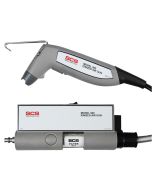
Conductive Vinyl Floor Tiles
- Resilient ESD High Gloss, Durable 2.0mm & 3.2mm Vinyl Tile
100% pure homogeneous vinyl with proprietary ESD flooring composition. - Precision Cut
Allows the tiles to be laid tight without gaps that collect dirt. - Low-cost Maintenance
Easily cleaned and shined to a gloss while maintaining its electrical properties. - Electrical Resistance: 2.5 x 104 to < 1 x 106 ohms
Meets ANSI/ESD S20.20 flooring required limit tested per ANSI/ESD STM7.1 and ESD TR53, and is a suitable flooring component for personnel grounding Footwear / Flooring System.
Note: ESD Vinyl Floor Tiles Require Special Installation using recommended 8453 Solvent-Free Conductive Epoxy Adhesive and 81524 Copper Foil Grounding Strips. Adhesive and Grounding Strips are sold separately.
| Código PAC | C100334 |
|---|---|
| Marca | Statguard |
| ESD certificado | Sí |
| Propiedades ESD | Conductivo |
| Material | Vinilo |
8400 Series Statguard® Vinyl Floor Tile is a long-term solution for helping control ESD. This durable and attractive vinyl tile can easily be installed by competent flooring contractors (using conductive adhesive and grounding strips). The flexible, resilient tiles are made with only 100% pure vinyl and contain a minimum amount of filler and none of the regrind that can make the tile brittle. The conductive version are available in a selection of bright, vivid colors. A proprietary manufacturing process completely seals in the conductive carbon medium, resulting in a unique tile that can be easily cleaned and shined to a gloss while maintaining its electrical properties - without the use of an ESD wax or polish.
Meets ANSI/ESD S20.20 flooring required limit tested per ANSI/ESD STM7.1 and ESD TR53, and is a suitable flooring component for personnel grounding Footwear / Flooring System.
Per ANSI/ESD STM7.1 / Annex A: The resistance of 1 x 106 ohms is historically a number used to define the point where the conductive range becomes dissipative for flooring. The difference in the actual ESD properties of the floor is negligible between 5.0 x 105 and 5.0 x 106 ohms. Therefore, the slight variations at 1.0 x 106 ohms have negligible effects on ESD properties. Based on variations in instrumentation and other conditions, materials that test close to or at 1.0 x 106 ohms may be classified in either the conductive or dissipative range














